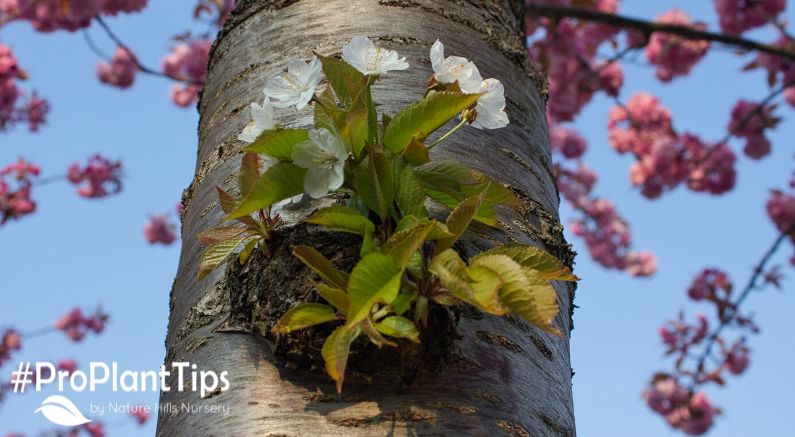
An important part of tree pruning and maintenance is dealing with suckers and water sprouts. These fast-growing stems pop up often on both grafted trees and naturally thicket-forming trees. Removing them not only boosts plant vigor and overall health but also keeps your trees neat, tidy, and closer to their natural form.
When left unchecked, suckers and water sprouts drain energy, reduce flowering and fruiting, and make trees more prone to disease and pests. Trees under stress are the most likely to produce suckers and water sprouts, making proper tree care and prevention essential.
Read on to learn how to manage these common growths and keep your trees thriving!
- What are Tree Suckers?
- How To Control Tree Suckers
- What Are Tree Water Sprouts?
- How To Remove Tree Water Sprouts
- Preventing Tree Suckers & Water Sprouts
- Keep Your Trees Happy & Healthy
What Are Tree Suckers?
Tree suckers are new shoots that emerge from the ground or around the base of a tree. They can quickly out-compete the main trunk or branches, stealing nutrients and water. While some plants naturally sucker as part of their growth habit, others only do so when stressed.
Trees that commonly sucker include:
- Native American Hazelnuts
- Wild Plums
- Hawthorn species
- Crabapples
- Redbud
- Birch
- Flowering Dogwood
- Pawpaw

While suckering is normal in colony-forming tree species, it is a sign of stress in non-suckering varieties.
In stressed trees, suckers act as survival shoots. Unfortunately, unless naturally part of a species' growth, these unwanted shoots literally suck the life out of the tree, reducing vigor, fruit set, and producing irregular growth.
What Causes Suckering?
Suckering can happen for several reasons, even in species that do not usually form them. Most often, it's a stress response:
- Root damage or plant stress
- Planting the tree too deeply in the ground
- Over-pruning or cutting back too severely
- Disease or insect pressure
- Failure of the graft, or death of the grafted portion
Stressed trees typically produce suckers as a last-ditch effort to survive. Grafted trees are especially prone to this, since if the desirable graft is weakened, the rootstock beneath may push out new shoots.
How To Control Tree Suckers
Removing suckers is very similar to regular tree pruning:
- Cut suckers away at the base of the tree, as close to the trunk or roots as possible.
- Use sharp, clean pruners, and avoid cutting into the trunk collar or bark.
- For suckers emerging from roots, carefully dig down with a spade to sever them at the source.
Bonus Tip: Some suckers may develop their own root systems. If the tree is not grafted, these shoots can be transplanted elsewhere as free new plants! For grafted trees, however, removing them is essential, as they will not grow into the desired cultivar.
Info About Grafted Trees and Suckers
- On own-root trees, suckers may eventually grow into healthy replacements if the top dies back.
- On grafted trees, suckers below the graft union are rootstock growth, not your chosen cultivar.
Example: A Crabapple tree showing both pink and white flowers often has unnoticed rootstock suckers growing alongside the grafted top.
To check if your graft is alive, do a Scratch Test: scrape a small section of bark at the graft.
-
If green underneath, the graft is alive. Remove the suckers and care for the tree.
- If brown or tan, the graft has failed. The remaining plant is only the rootstock, which may produce very different flowers or fruit.
What Are Tree Water Sprouts?

Water sprouts are vertical, fast-growing shoots that form along branches or the trunk of a tree. Shooting straight up, these sprouts can grow several feet in one season and:
- Crowd the canopy, reducing air circulation and light penetration.
- Steal energy without producing flowers or fruit.
- Break easily, leaving wounds that invite pests and diseases.
Leaves on water sprouts may look different from the rest of the tree, adding to their messy appearance. Left unchecked, they weaken the canopy and create storm hazards.
What Causes Water Sprouts?
Water sprouts often form when a tree is stressed by:
- Extended heavy rainfall
- Drought
- Soil compaction
- Over-pruning or topping
Some tree species are naturally more prone to sprouting water shoots than others.
How To Remove Tree Water Sprouts
- The best time to prune water sprouts is early spring, before leaves emerge.
- Remove them as soon as they appear, even in summer, so pruning jobs don't pile up.
- Use sharp pruners to cut them flush to the limb, avoiding cuts into the trunk collar.
- As with renewal pruning, never remove more than one-third of the canopy at a time.
Preventing Tree Suckers & Water Sprouts
A healthy tree is far less likely to produce suckers and sprouts. Prevent problems by following these tree care practices:
-
Plant at the correct depth - only as deep as in the nursery container, or to the original soil line on bareroot trees.
- Fertilize wisely - use slow-release fertilizers and water deeply during drought or extreme heat.
-
Mulch correctly - apply 3-4 inches of arborist mulch around the base, but keep mulch away from the trunk.
- Prune carefully - never remove more than one-third of growth at once, and avoid topping trees.
- Check regularly - survey trees each spring before leaf-out to spot suckers and sprouts early.
Keep Your Trees Happy & Healthy
Tree suckers and water sprouts are simply signs of stress. With mindful care, the right pruning techniques, and consistent seasonal checkups, you'll keep your trees strong, productive, and beautiful.
Redirecting the tree's energy back into flowers, fruit, and strong branching means more shade, beauty, and harvests for years to come. A little maintenance now saves a lot of problems later.
Happy Planting!


